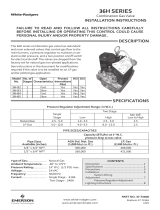
6
LIGHTING INSTRUCTIONS
A. This appliance has a pilot that must be lighted by
hand. When lighting the pilot, follow these instruc-
tions exactly.
B. BEFORE OPERATING smell all around the appli-
ance area for gas. Be sure to smell next to the oor
because some gas is heavier than air and will settle
on the oor.
FOR YOUR SAFETY
“WHAT TO DO IF YOU SMELL GAS”
any phone in your building.
-
department.
C. Use only your hand to push in or turn the gas
control knob. Never use tools. If the knob will not
push in or tun by hand, don’t try to repair it; call a
qualied service technician. Force or attempted
repair may result in a re or explosion.
D. Do not use this appliance if any part has been
under water. Immediately call a qualied service
technician to inspect the appliance and to replace
any part of the control system and any gas control
which has been under water.
may result, causing property damage, personal injury or loss of life.
FOR YOUR SAFETY READ BEFORE OPERATING
1. Set the thermostat to lowest setting.
2. Turn o all electric power to the appliance if service
is to be performed.
3. Turn gas control knob clockwise to PILOT.
4. Depress gas control knob slightly and turn clockwise
to OFF. Do not use tools or excessive force.
TO TURN OFF GAS TO APPLIANCE
1. STOP! Read the precautionary information above.
2. Set the thermostat to lowest setting.
3. Turn o all electric power to the appliance.
4. Depress gas control knob slightly and turn clock-
wise to OFF (see g. 10). If knob is in ON, turn
clockwise to PILOT, then depress knob slightly and
turn clockwise to OFF.
NOTE: Knob cannot be turned from PILOT to OFF
unless knob is depressed slightly. Do not use tools
or excessive force.
5. Wait fteen (15) minutes to clear out any gas. If you
then smell gas, STOP! Follow B in the precaution-
ary information above. If you don’t smell gas, go to
next step.
6. Remove the pilot access panel(s) located under the
gas control unit.
LIGHTING INSTRUCTIONS
7. Find pilot - follow small metal tubes from gas
control.
T
8. Turn knob on gas control counterclockwise to PILOT.
9. Depress control knob all the way and hold in. Im-
mediately light the pilot with a match. Continue
to hold the control knob down for about one (1)
minute after the pilot is lit. Release knob and it will
pop back up. Pilot should remain lit. If it goes out,
repeat steps 4, 5, 8, and 9.
• If knob does not pop up when released, turn clock-
wise to OFF, stop and immediately call your service
technician or gas supplier.
• If the pilot will not stay lit after several tries, turn
the gas control knob to OFF and call your service
technician or gas supplier.
10. Replacepilotaccesspanel(s).
11. Turn gas control knob counterclockwise to ON.
12. Turn on all electrical power to the appliance.
13. Setthermostattodesiredseng.
OFF
PILOT
ON
Knob
36C Series
Indicator
Gas cock
knob
Figure 9. Gas Cock Knob
ON
OFF
PILOT
Figure 10. Gas Cock Knob







